For pole-residue, the values in the synthesis table must be identical in order to
be identified as a multiple order pole. Thus, if you convert the synthesis table
from polynomial to pole-residue format, then add a pole that appears to be the
same, it probably won’t be identified as the same pole due to rounding errors in
the conversion.
Reconstructing Simple Poles
To reconstruct the pole-residue equation from the synthesis table, you must
associate poles with their residues. Poles and their residues are always on the
same line in the synthesis table.
The equation for a simple residue over a simple pole is:
where:
(residue) is the real residue in the table and its sign
(simple pole) is the real pole and its sign shown
in the table across from the residue
Placing a complex conjugate residue over a simple pole creates a
non-Hermitian symmetric transfer function. These should not be synthesized.
Also, table conversions are not allowed. The message “Not Hermitian” is
displayed if coefficients from Pole Residue synthesis-tables are in a table when
table format conversion is attempted. The analyzer’s curve fitter will not work
with a non-Hermitian frequency-response trace (because it is not possible for
our pole-zero format to have non-Hermitian table entries).
(Residue)
s - (Simple Pole)
Pole Residue Equations
This pole residue equation results from the partial-fraction expansion of a corresponding
pole-zero equation.
Pole-zero equation:
Pole-residue equation:
Hs
s
ss js j
()
()
()()()
=
×+
++− ++
1 10 600
250 500 2000 500 2000
6
Hs
s
j
sj
j
sj
()
.. .. .
=
+
+
−−
+−
+
−+
++
86 154
250
43 077 244 62
500 2000
43 077 244 62
500 2000
Agilent 35670A
Operator's Guide Synthesis Option 1D3
15-7
